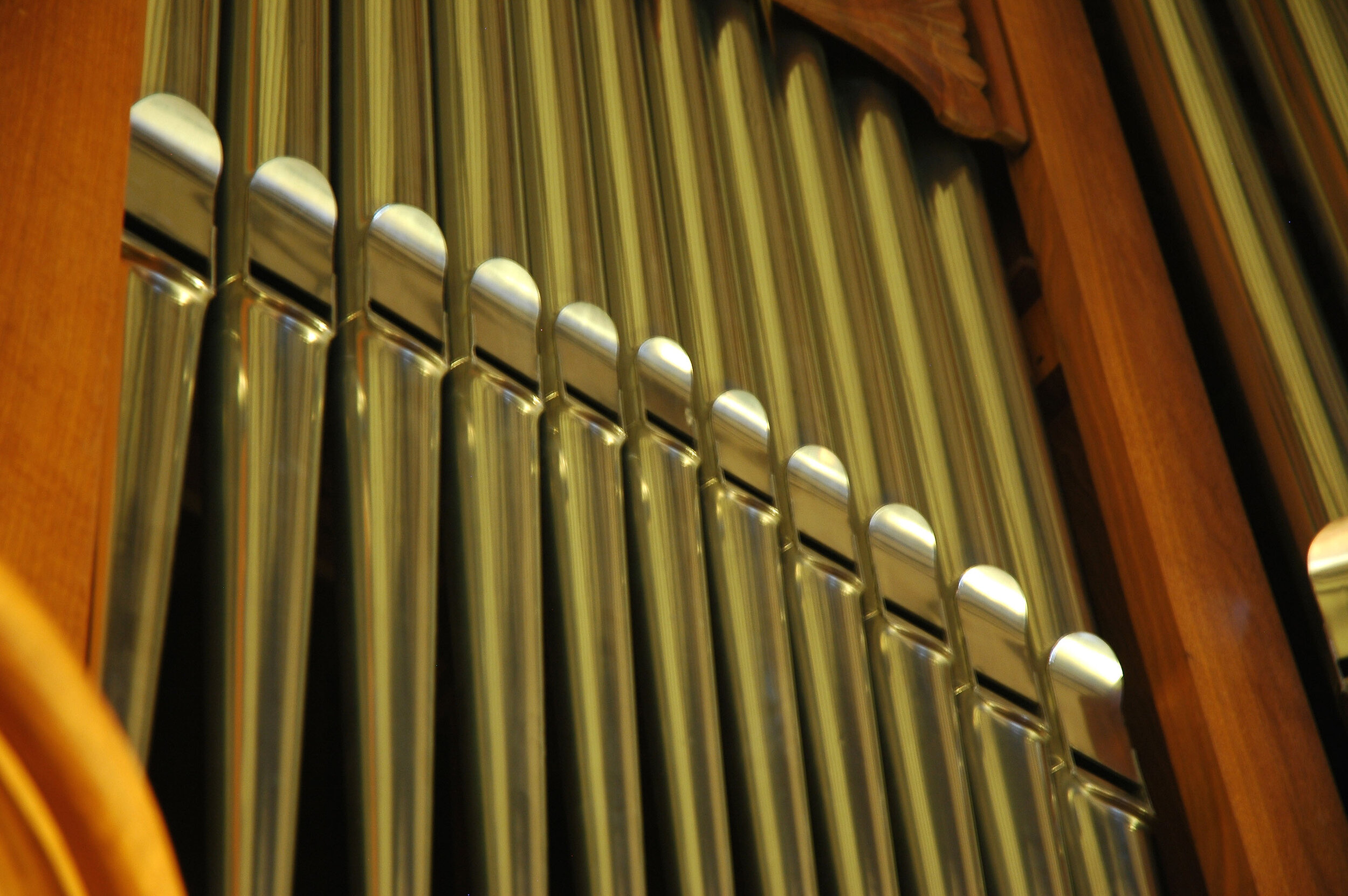
Jaeckel Organ, Opus 11 (1988)
The organ of Pilgrim Congregational Church was build by Jaeckel, Inc., of Duluth and was installed between October, 1987, and May, 1988. The organ replaced a seventy-year-old instrument that was located in the chancel area of the sanctuary. That organ, built in 1917 by J. W. Steere & Son Organ Company (Opus 693), of Springfield, Mass., was sold to the Irving Park Baptist Church of Chicago, Ill. Three stops from the Steere organ were used in the Jaeckel instrument.
Pilgrim’s Jaeckel organ was made possible through a generous bequest from the estate of John Dalton, in combination with other generous pledges and gifts. The organ was dedicated during the Sunday morning worship on October 3, 1988. The world-renowned organist Marie-Claire Alain gave the inaugural recital on November 1, 1988.
Specifications
3 manuals
49 stops
67 ranks
3,210 pipes
RÉCIT EXPRESSIF (manual III)
Jeux de Fonds
Quintaton 16’
Diapason 8’
Viole de gambe 8’
Bourdon 8’
Voix céleste 8’
Flûte octaviante 4’
Basson-Hautbois 8’
Voix humaine 8’
Jeux de Combinaison
IV Cornet 4’
Octavin 2’
I-III Carillon 2 2/3’
Basson 16’
Trompette harmonique 8’
Clairon harmonique 4’
GRAND-ORGUE (manual II)
Jeux de Fonds
Montre 16’
Montre 8’
Bourdon 8’
Flûte harmonique 8’
Prestant 4’
Jeux de Combinaison
Quinte 2 2/3’
Doublette 2’
II Gross Fourniture 2’
IV Fourniture 1’
III Cymbale 1/2’
V Cornet 8’
Trompette 8’
Clairon harmonique 4’
POSITIF (manual I)
Jeux de Fonds
Bourdon 16’
Montre 8’
Bourdon 8’
Prestant 4’
Flûte 4’
Jeux de Combinaison
Grosse Tierce 3 1/5’
Nasard 2 2/3’
Doublette 2’
Tierce 1 3/5’
Larigot 1 1/3’ IV
IV Plein-Jeu 1’
Trompette 8’
Cromorne 8’
PÉDALE
Jeux de Fonds
Bourdon 32’
Montre 16’
Soubasse 16’
Principal 8’
Flûte de pédale 8’
Flûte 4’
Contre Bombarde 32’
Jeux de Combinaison
Bombarde 16’
Trompette 8’
PÉDALES DE COMBINAISON
Rossignol (bird call)
Tirasses Grand-Orgue, Positif, Récit
Anches Pédale, Grand-Orgue, Positif, Récit
Fonds Grand-Orgue
Expression Récit (swell pedal)
Récit sur Grand-Orgue
Positif sur Grand-Orgue
Récit sur Positif
Tremolo du Récit/Positif
Design Details
The organ has a Cavaillé-Coll style console, including terraced stop jams, mahagony construction, pedal, keyboard and dimensions.
The instrument is inspired by the 1884 Cavaillé-Coll organ in the Abbaye Aux Hommes in Caen, France.
The organ is of mechanical-action (“tracker”) design. All keys have mechanical linkages to the valves under the pipes. Stops are controlled by mechanical linkages, as well. The only electrical item in the organ is the blower.
The organ makes use of ventil pedals, rather than the traditional electric combination action. In this design, certain stops (normally mixtures, mutations and reeds) may be drawn in advance, but will not sound until the ventil pedal for the particular division is depressed. Iron combination pedals are from a 19th century French organ.
The Rossignol (bird call) stop consists of two small metal stops whose ends are immersed in a vessel of water.
All reeds are with completely French shallots.
Tuning is according to a scheme by Frencesco A. Vallotti, rediscovered in 1975 by van Biezan: a' = 440~ at 70 F.
Suspended key action for all keyboards.
No Pneumatic assists for key, coupler, or stop actions.
G.O. Cornet can be included or subtracted from G.O. Anches by turning the stopknob a quarter turn.



Historical Information
Adapted from information originally compiled by Michael Zlonis in 2008:
It is highly unusual that a church can rely in the talents of a local organ builder in the creation of a new organ. Moreover, Dr. Jesse Eschbach (Professor of Organ at the University of North Texas, Denton, TX, and former faculty member at the University of Minnesota Duluth) and Dr. Norma Stevlingson (Professor of Organ at the University of Wisconsin – Superior) served as design consultants. Steve Morgan (former Pilgrim Music Director and organist) was also highly involved during the planning stages.
Many Pilgrim members, pastors and staff helped support the building of the organ. Key individuals include Ted Harwood, who chaired the organ committee, and Wally Niss, who served as coordinator between the church and builder Dan Jaeckel during the construction process. The team of builders who worked on the instrument were: David Rollin, Frank Mehle, John Thoennes, David Hanlon, Dean Hauge, Pete Macartney, Peter Pestalozzi, Hal Gober and Warren Post.
Pilgrim’s organ has been played in recital by many outstanding organists, including; Marie-Claire Alain, Jesse Eschbach, Norma Stevlingson, Gunther Fetz, Robert Glascow, David Craighead, Thomas Froelich, Clyde Holloway, Marie-Madeleine Duruflé, Robert Anderson, Stephen Hamilton, Richard Heschke, James Higdon, David Schrader, Delbert Disselhorst, Martin James, Marie Louise Langlais, James Kibbie, James David Christie, Olivier Latry, Thomas Trotter, and Andrew Tessman.
Several organists have made recordings on the organ, including David Schrader, Janet Hunt and James Higdon.
Pilgrim’s organ was featured in the May 1991 issue of The American Organist, the American Guild of Organists’ monthly magazine.
Hear the Organ
There’s a lot more on our YouTube channel.



